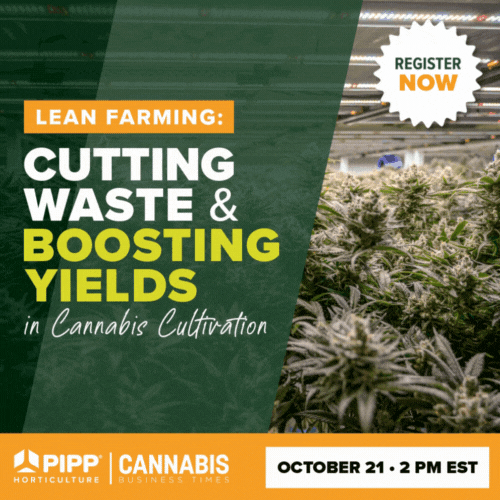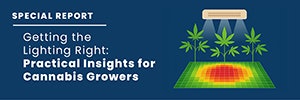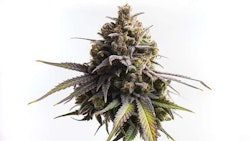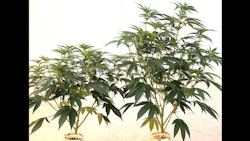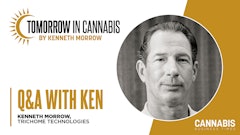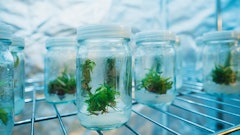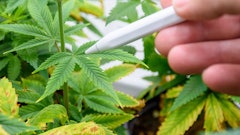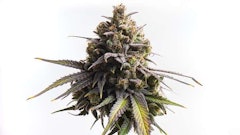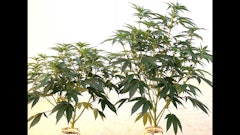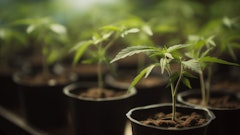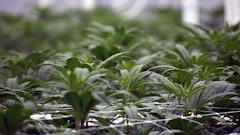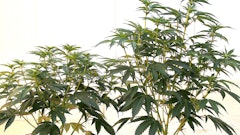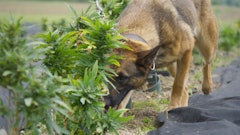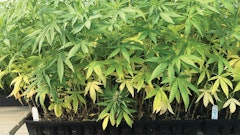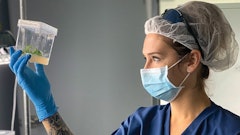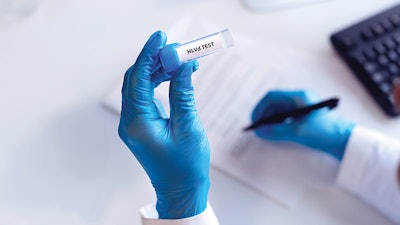
HLVd, HpLVd, HLV, duds, dudders, the hops, hop latent viroid. Whatever you decide to call it, this 256-base-pair, circular RNA molecule, identified in cannabis almost exactly 5 years ago, continues to torment those who cultivate cannabis professionally.
Despite the pain, we have learned considerably about HLVd’s interaction with and negative effects on cannabis. There have been notable peer-reviewed publications and conference presentations, as well as valuable posts from growers and researchers alike. So far, there has not been more than a loose hypothesis on how HLVd wreaks havoc on cannabis but the gravity of the problem is crystal clear. In a previous article I co-authored for Cannabis Business Times shortly after the discovery, we traced the symptomatology of HLVd while drawing attention to what are sure to be further emergent viral pathogens as cannabis expands into conventional agriculture.
To sum up some of the main findings of the past years:
- HLVd dramatically reduces yields. A producer of laboratory tests put the number at 50% less yield in weight for one Oklahoma facility. A year later, a scientific publication showed an approximately 30% reduction in weight and THC content across four different cultivars. For reasons still unknown, some infected cultivars are less prone to symptoms than others. While the hop industry ultimately settled on resistant varieties, the breeding of resistance in cannabis is still an ongoing project.
- HLVd spreads readily. We continue to caution growers and facility workers that the main method of spread is mechanical and the first line of defense is stringent phytosanitary and quarantine measures. A 10% bleach solution (made daily) for disinfecting tools is a surefire way to prevent spread between plants and there are alternative products that will be less corrosive on metal. Alcohol is useless, and it might in fact make the problem worse. One overlooked avenue of transmission is plants sharing water via runoff and not disinfecting irrigation lines and stakes regularly. HLVd has been detected in root aphids, and although it has not been demonstrated conclusively, insect-mediated transmission is certainly a possibility.
- HLVd is elusive in facilities and plants. The overwhelmingly asymptomatic presence of HLVd in vegetative plants means that the consequences become apparent only after it is too late. This viroid is sneaky not only in a facility but also in the plant as it can be present in one part and not the other, making good sampling crucial for accurate testing.
- While difficult, it is possible to eradicate HLVd from prized varieties. This has been one of the value propositions of the still struggling cannabis tissue-culture industry. Although elimination of HLVd is certainly possible by in-vitro cultures of meristems undergoing thermal therapy, it is a long (6 months or more) and costly process.
- HLVd is pervasive. Emerging from the West Coast, HLVd is now in the majority of North American facilities and is spreading globally. Testing companies claim infection rates of 33% in 2021 in the U.S., and researchers show an average 25% infection rate in Canada during the three years between 2020 and 2022.
HLVd can break cannabis cultivation. I’ve personally witnessed multiple operations forced to scrap everything and start over. The potential loss resulting from an uncontrolled outbreak has compelled companies to spend hundreds of thousands of dollars on the only practical tool available: testing. As a consequence, the growth of the testing industry has been impressive. From my back-of-the-envelope calculations and conversations with a number of people in the sector, I estimate that testing for this one single viroid has become a multimillion-dollar business on its own and has created companies centered around it. At last count, I was able to identify more than 20 laboratories offering HLVd testing services in the U.S. with prices ranging from $6 to $70 per test. The marketplace is becoming even more saturated, and it can be confusing for a nursery or commercial cultivator to make the right choice while looking for a testing lab. In this article, I outline the main factors to consider when looking for an HLVd testing solution.
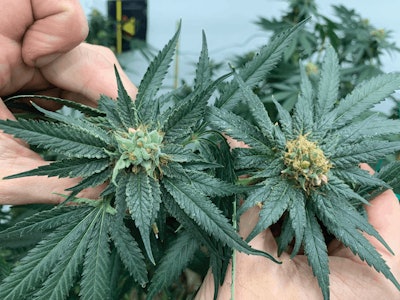
The Method
Rapid test strips of the kind that were flooded onto the market during the pandemic and that are also available for some plant viruses are not useful for naked RNA viroids that do not have any protein for conjugated antibodies to bind to. Fortunately, there are numerous methods for detecting nucleic acids (RNA and DNA) and more are being developed every day. But the most established method and that which modern molecular biology is built upon is another pandemic darling, the polymerase chain reaction (PCR).
In its simplest form, PCR makes about a billion copies of a DNA molecule by priming the reaction with two known regions of the molecule. An amplification process happens by moving the reaction through distinct steps mediated by heating and cooling cycles. PCR has gone through many improvements since its invention in 1983 by Kary Mullis, who ultimately received a Nobel Prize for it 10 years later. During the first experiments, tubes were manually moved between different temperatures. This is now achieved with thermoelectrics. The polymerase enzyme replicating DNA had to be supplemented throughout the reaction, as it denatured during the heating steps. Today, a thermostable version isolated from a bacteria, Thermus aquaticus, found in the geysers of Yellowstone National Park, is the industry standard.
Two other significant iterations of PCR relevant to testing for HLVd, and other pathogens, became common in the ’80s and ’90s. The ability to easily detect RNA was achieved by incorporating a step to synthesize DNA from an RNA molecule prior to PCR with an enzyme called reverse transcriptase (the RT in RT-PCR). This was a discovery stemming from research that brought Nobel prizes to David Baltimore, Renato Dulbecco and Howard Martin Temin in 1975. A second improvement was to automate the interpretation of results in a closed-tube, real-time manner with the use of fluorescent molecules.
The design of a PCR assay can come across as straightforward and is possible via widely accessible free online tools. But a good PCR assay requires care as well as a thorough quality control process to make sure it can successfully detect known variations of the target while avoiding cross reactivity with similar nucleic acids from other organisms that might be present in the sample. The design of the primers should take into account all published HLVd sequence data and put emphasis on the “upper and lower conserved regions” of the HLVd genome. Some testing labs ensure against sequence variation by probing two distinct regions. In addition to the design, there are two essential quality control steps; determining the limit of detection (LOD)—i.e., the minimum amount of viroid that can be detected with confidence—and checking against potential false positives from cross reactivity.
The LOD will be determined by using an analytical standard that is pure, quantified viroid. In a perfect world, companies specializing in certified reference materials would also sell HLVd standards. One could argue that this wouldn’t even be a niche product anymore. But, unfortunately, this does not exist yet, and labs need to synthesize their own for quantification. This RNA standard can be a linear molecule or circularized to resemble HLVd in nature, as closely as possible. The standard used to quantify the assay will also need to be quantified. This is usually done by methods using absorbance or fluorescence if the more sophisticated digital droplet PCR methods providing absolute quantification are not readily available. Finally, the determination of LOD must be done by spiking the synthetic standard into cannabis RNA or uninfected cannabis tissue samples to simulate the performance of the assay in real-world situations.
The potential of false positive results due to interacting with microorganisms or other organic contaminants should be minimized. Genomic information for these possible microbes is available in public databases, and primers and probes can be tested against it. These software-based, in silico methods are necessary, but nothing beats empirically testing the assay against samples or cultures of microbes as well as diverse cannabis genotypes. Unfortunately, for labs who have not been collecting pathogen samples or are not integrated into the cannabis industry or farming communities, it might be difficult to have access to samples for empirical confirmation.
The adage that “your experiment is only as good as your controls” is certainly applicable in molecular diagnostics. Well-designed controls account for the testing process as well as the integrity of the materials. In the case of HLVd, this means having a parallel RT-PCR reaction that is specific to cannabis mRNA—what we call an “internal control for an endogenous, house-keeping gene.” Many plant pathogen test developers will try to circumvent this. For example, one such company whose HLVd tests I evaluated had an artificial internal control target that was included in the reaction mix rather than developing one for cannabis. This means that it did not control for successful RNA extraction from cannabis plant tissue but only for the integrity of its product and its functioning.
The Sample
Labs and molecular assays don’t test plants, they test samples taken from plants. This is an important distinction that reminds us that good sample collection will give the most informative result on the plant it came from.
In my own experience, and in numerous studies by testing companies, we found leaves to be a poor sample type for detecting HLVd. Some might try to claim otherwise in order to sell convenient sampling methods, but the consensus is solidifying that rootstock acts as a sink for HLVd and will give the most accurate result in regards to its presence or absence in the plant. An alternative sample type that worked well for me were petioles and stems. The attraction in using stems is that clone production and sampling can be combined; one cut for the clone followed by another small one for the sample. Reducing the number of instances where wounds are made on potentially infected plants also reduces the risk of transmission. Imagine how many times HLVd must have spread in facilities due to poor sampling techniques.
HLVd moves into the rootstock, but its overall movement and replication is still evasive. It is essential to sample tissue not only from different parts of the plant but also during its life lifecycle. Testing can start out very intensive (screening) and after culling or isolating all positive plants, become a more reduced but still routine activity (surveillance and maintenance). This maintenance testing can even involve pooling plants together but only after discussions with your testing lab about maintaining accuracy.
At the beginning of screening a mother room population, it is best to start from smaller plants and ideally with a fresh cutting that is tested at the moment of propagation. This cut should be monitored by testing at least three more times at three-week intervals with samples taken from the roots as well as from petioles near the main stalk to ensure it is not infected with HLVd.
mRNA (involved in protein synthesis) is notoriously finicky and prone to degradation by environmental conditions and enzymes. This is not so much the case for HLVd, which, as a circular molecule, is stabilized by strong bonds between RNA bases. Although this makes the cold transport of samples between the sampling site and the testing lab less crucial, I have observed a loss in accuracy from testing samples that have been stored at ambient temperature. This will be even more important if the lab is using a proper internal control designed for cannabis mRNA. Some labs will ask for shipping with cold packs and others offer sampling tubes that contain an RNA stabilizing solution. In general, it is important to minimize the time between sampling and testing, and cultivators should be cognizant of this as they evaluate turn-around times of labs.
In the past year, there has been a growing understanding of the risk of vertical transmission of HLVd, or, in other words, transmission between generations as a result of sexual reproduction. At first, cultivators took at face value the low level of vertical transmission in hops or, even worse, they believed seeds would remain viroid free. Unfortunately, this has not turned out to be the case, and seed-borne transmission can be more than 80% of the progeny depending on the cultivar, the level of infection of the parents and if it was the pollen, the mother plant or both that were infected to begin with.
This puts great responsibility on seed producers to test their parents diligently prior to pollination. Seed buyers should ask to see testing data on the parents, the seed lot and even conduct tests on the seeds themselves. While I don’t believe they exist yet, calculator tools simplifying the statistics of how many seeds to sample from a lot, taking into account the number of parents, would allow us to reach acceptable confidence levels at a reasonable testing cost.
The Labs
Testing labs that offer PCR detection services for HLVd fall into two types. Select labs will design their own tests. The second type, the majority, will purchase their tests from commercial providers that design and sell reaction kits. To my knowledge of those selling tests to labs, only one exists that specializes solely on cannabis pathogens. All others are generalists and offer assays for a wide variety of plants and plant pathogens, and therefore might not have the comprehensive knowledge of cannabis genetics nor possess samples in-house to use during assay development.
Here are some of the essential questions a cultivator, nursery or breeder can ask a testing provider and expect to receive a response without being stonewalled by “proprietary information.”
- What kind of assay do you use? Did you design it or was it purchased from a third party? Which third party? Do you know which regions of the viroid it targets? How do you account for sequence variation?
- Do you have an internal control? What kind of internal control?
- What is your sample shipping process? How do you minimize RNA degradation?
- Can you provide me with validation data for your assay? Did you validate the assay yourself?
Also, make sure to look for the LOD, information on how they measure their LOD and cross-reactivity data.
Interlaboratory comparison studies and proficiency tests are essential for regulated testing markets ranging from human diagnostics to plant pathogens. In the U.S., industry associations such as the National Plant Diagnostics Network provide laboratory accreditation services, and some countries, especially those who need to take phytosanitary measures seriously (i.e., isolated ecosystems such as Australia), will conduct proficiency testing of their plant diagnostic labs. Cannabis, despite growing in acreage and capital, and overly regulated when it comes to farming and taxing, is still not subject to considerations around the long-term health of the plant, such as ensuring accurate diagnostics of diseases. Therefore, it is up to us to conduct these studies ourselves.
Considering the biology of HLVd, and its elusive interaction with the cannabis plant, it is important to conduct comparisons in a way that will give the best data possible. Again, the guiding principle is that the labs are testing samples, not plants, therefore a single freshly collected sample should be split equally into the number of labs being compared to each other and sent immediately. When choosing the plants to sample for comparing labs, choose different cultivars at different ages as well as plants you know or suspect to be infected and those you know or suspect to be clean. Getting hands-on experience with different sample collection and processing procedures will provide insight into implementing both on a larger scale.
On-Site Testing
Your particular situation will decide how many tests you conduct and at what frequency. Most crucially, nurseries supplying starts to farmers should take HLVd testing seriously, since any slip up will affect their customers after it is too late in the season. These nurseries might benefit from the various solutions on the market for in-house, on-site testing. Once testing numbers reach thousands per month, this type of testing can allow for immediate actionable results with clear cost savings.
Not all testing modalities are equal, and for in-house testing, the gold-standard PCR might not be the appropriate one. PCR methods usually require a sizable capital expenditure as well as personnel with at least a minimal amount of wet-lab experience. This cost can be prohibitive for a cannabis cultivation company already operating on tight margins. Fortunately, an alternative exists: isothermal amplification.
There are at least five different on-site testing options on the market that I am aware of. One of them is from a plant pathogen test manufacturer and uses the reaction recombinase polymerase amplification (RPA). The other four are offerings from different cannabis pathogen testing labs and are built upon loop-mediated isothermal amplification (LAMP). Some of these companies will require you to buy their devices alongside their tests, while others will bundle basic lab equipment free of charge.
LAMP was developed by scientists at the Eiken Chemical Corporation more than 20 years ago and is a technique particularly amenable to field-based testing. It takes place at a single temperature (isothermal) and therefore does not require thermal cycling. The reaction, and the enzyme catalyzing it, is quite tolerant to inhibitors and so works well with crude sample preparations and cuts down on prep time. It is able to produce nearly 100-fold more amplification copies than PCR in about half the time, which allows for a variety of methods enabling you to see visual results. This increase in amplification yield brings along the risk of false positives by contaminating your workspace, but fortunately there are modifications to the reaction that can eliminate this. It is primarily a qualitative method unable to produce viroid copy numbers, but a yes/no answer is sufficient when you are trying to eliminate infected plants.
Just as not all PCR tests are created equal, not all LAMP tests are created equal. In fact, designing a robust, sensitive and specific LAMP assay is considerably harder than PCR-based ones. But those with the expertise will be able to design reaction mixes that rival PCR and also include cannabis-specific internal controls. If you are in the market for on-site testing, the questions above (apart from the one on shipping) apply here as well. An additional question that should be asked is how they ensure there is minimal risk of contamination.
Case Studies
Two examples of interlaboratory comparisons I conducted over the years are illustrative of differing approaches toward HLVd detection/testing. Both were done at fairly large nurseries servicing their respective states of Oregon and California. I or a member of our team conducted site visits to both locations and advised them over the course of months to make the best testing decision. Both nurseries had already been testing with commercial labs but were exploring alternatives.
For the Oregon nursery, accuracy was paramount since they were frustrated by conflicting results from their testing provider. Together with the nursery, we conducted two separate trials and tested four labs from three different states against each other. Participating labs were aware of the comparison study. At the end, two out of four testing solutions were eliminated by the nursery for reasons of accuracy and ease of implementation. Having narrowed down the options, they chose the more affordable lab for their regular testing while relying on the other as a backup and partner to conduct various research projects. They have made HLVd surveillance an integral part of their nursery business and provide up-to-date results on their website.
The California nursery, in Santa Barbara County, provides a contrasting situation. I did a comparative study where samples were collected from 20 plants and tested across three different labs. Two out of three provided a 70% match in results pointing to at least 7 positives, while the third lab, which they were a customer of, produced negative results across the board. The nursery responded by claiming that nobody could really know if a sample was positive or negative, questioning whether the two tests that had matching results were both wrong, and suggesting maybe testing wasn’t even necessary. They continued with their current testing provider, who offers the cheapest tests on the market.
This second example is illustrative in its eerie similarity to the analytical chemistry labs who are notorious for using subpar methods (at best) or cooking the books (at worst) to provide inflated results to their customers. In a cut-throat market where THC content is relational to profit, labs offering a potency percentage sometimes 10 points higher than the next one will undoubtedly be preferred. The unfortunate situation is that some nurseries will also go along with labs who might offer clean bills of health for the cheapest price even if it means putting their customers at a disadvantage. Ultimately, they can pass the buck down and claim that the infection happened while the product was in their customer’s possession.
The Horizon
Walking around the Mary Jane cannabis trade show in Berlin a few weeks ago, I noticed a scary vibe of denial. The majority of germplasm providers were seed producers and distributors, but there were a couple dozen booths selling cuttings as well. As mentioned above, seed producers also need to be cognizant of HLVd, but since the issue is more pervasive in vegetative propagation I decided to conduct an informal survey of those selling cuttings. I talked to about 10 individuals selling clones and while they were all aware of HLVd, none of them had a screening system in place and some were even nonchalant, saying they heard it was a “California problem.” The problem surely originated from the West Coast but considering the high level of germplasm export from the cannabis tastemaker state to the rest of the world, it has now spread globally. Indeed, my own testing, ranging from suppliers of cuttings in Vienna to CBD flowers in Spain, suggests high levels of HLVd in the European continent.
Businesses built around HLVd will continue to grow in the near future as legal cannabis cultivation increases in scale. More companies will offer testing, remediation and products with various claims of fighting and fending off HLVd. Nurseries and seed makers will need to assure their customers of clean germplasm. Breeders will start to develop resistant varieties that are backed by data.
Pathogens are a collective problem. For decades we have enjoyed sharing flower and cuts. Unwittingly we have also shared cannabis pathogens. As businesses compete with each other, it is also paramount that we share and collaborate on the science of HLVd transmission, disclose any mutations we might encounter that can throw off diagnostics and, most importantly, sound the alarm as soon as we identify the next novel cannabis infectious agent.
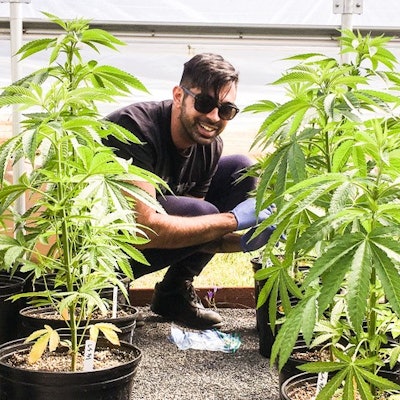
Ali Bektaş is a plant molecular biologist working in cannabis agriculture. His journey with HLVd spans across multiple companies and ranges from the initial discovery of HLVd in cannabis to developing custom testing solutions for facilities. He can be reached at [email protected].

